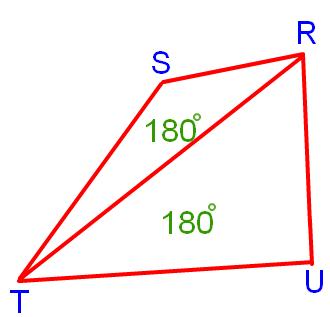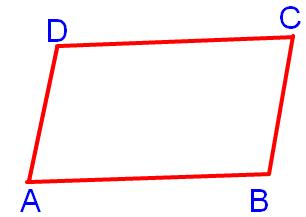Sum of Angles of a Quadrilateral
Sum of angles of a quadrilateral are discussed here. We have now two triangles in the below figure.
We know, the sum of the angles of a triangle = 180°
Since there are two triangles,
therefore, the sum of two triangles is 180° + 180° = 360°
Note: The sum of the four angles is 360°.
For Example:
1. In a quadrilateral ABCD, ∠A = 100°, ∠B = 105° and ∠C = 70°, find ∠D.
Solution:
Here the sum of the four angles
or, ∠A + ∠B + ∠C + ∠D = 360°
We know, ∠A = 100°, ∠B = 105° and ∠C = 70°
or, 100° + 105° + 70° + ∠D = 360°
or, 275° + ∠D = 360°
∠D = 360° - 275°
Therefore, ∠D = 85°
2. Find the measure of the missing angles in a parallelogram, if ∠A = 70°.
Solution:
We know the opposite angles of a parallelogram are equal.
So, ∠C will also measure 70°
Sum of angles = 360°
∠A + ∠B + ∠C + ∠D = 360°
or, 70° + ∠B + 70° + ∠D = 360° (We know, ∠A = ∠C )
or, ∠B + ∠D + 140° = 360°
or, ∠B + ∠D = 360° - 140°
or, ∠B + ∠D = 220°
But ∠B = ∠D (Because opposites angles of a parallelogram are equal)
∠B = ∠D
= 220° ÷ 2
= 110°
Therefore, ∠B = 110°, ∠C = 70° and ∠ D = 110°
Construction of Perpendicular Lines by using a Protractor.
Sum of Angles of a Quadrilateral.
Practice Test on Quadrilaterals.
5th Grade Geometry Page
5th Grade Math Problems
From Sum of Angles of a Quadrilateral to HOME PAGE
Didn't find what you were looking for? Or want to know more information about Math Only Math. Use this Google Search to find what you need.
Recent Articles
-
Counting Numbers from 1 to 50 | Match the Number | Missing Numbers
Apr 04, 25 03:46 PM
In counting numbers from 1 to 50, recognize the numbers, count and then join the numbers in the correct number order. Here we mainly need eye-hand coordination to draw the picture and maintain the num -
Counting Eleven to Twenty with Numbers and Words |Numbers from 11 - 20
Apr 04, 25 03:21 PM
Counting eleven to twenty with numbers and words are explained below. One ten and one more is eleven. Eleven comes after ten. One ten and two more is twelve. Twelve comes after eleven. -
5th Grade BODMAS Rule Worksheet | PEMDAS | Order of operations|Answers
Apr 03, 25 03:11 PM
In 5th Grade BODMAS Rule Worksheet you will get different types of problems on mathematical expressions involving different operations, mathematical expression with 'brackets' and 'of' and simplifying… -
Worksheet on Simplification | Simplify Expressions | BODMAS Questions
Apr 03, 25 02:58 PM
In worksheet on simplification, the questions are based in order to simplify expressions involving more than one bracket by using the steps of removal of brackets. This exercise sheet -
Divisible by 2 Video |Test of Divisibility by 2 Trick| Rules| Examples
Apr 03, 25 10:25 AM
A number is divisible by 2 if the digit at unit place is either 0 or multiple of 2. So a number is divisible by 2 if digit at its units place is 0, 2, 4, 6 or 8.







New! Comments
Have your say about what you just read! Leave me a comment in the box below. Ask a Question or Answer a Question.